A Look At OS X Yosemite And iOS 8.1
by Brandon Chester on October 27, 2014 8:00 AM ESTContinuity
By far the most exciting features that Apple has created this year are part of continuity. Continuity is essentially an umbrella term for all the features that allow iOS and OS X devices to work together. Apple has always had some degree of integration and commonality, but continuity is really the first time Apple has really taken advantage of the ecosystems they have created and brought customers into. The key word there is ecosystems. Going forward, the power of a product and service ecosystem is going to be a key point of differentiation between companies that make their own software and those that piggyback off of another platform.
Unfortunately, users who only have a single device or have products spread out across many companies and operating systems are unable to take advantage of these sorts of features. The topic of platform lock-in is a complicated one and could spawn a whole article in itself, so I won't go into detail with it. What Apple users need to know about continuity is they need to have two or more supported devices. The heavily connected continuity features like Handoff and Airdrop will require Bluetooth 4.0 support which limits devices on the OS X side to Macs released in the last few years. Apple has also disabled Handoff on the 2011 MacBook Airs and 2011 Mac Mini despite their support for Bluetooth 4.0. iOS users will need an iPhone 5 or later, iPad 4th generation / Mini 1 or later, or the iPod Touch 5th generation. Like with Airdrop, the iPad 3 is left out when it comes to Handoff support, but it does support SMS and Call Forwarding.
Handoff
Handoff is the big star of the show when it comes to leveraging the power of an ecosystem and controlling the software on every device you sell. It allows you to start tasks on one device and continue them on another, provided the application supports it. As of right now the list is as follows, but it will continue to expand with both Apple's applications and third party ones from developers implementing Handoff into apps that have versions for both OS X and iOS.
- Safari
- Contacts
- Calendar
- Reminders
- Maps
- Messages
- Pages
- Numbers
- Keynote
The way Handoff works depends on which direction you're going. As you can see above, when transitioning from an iOS device to a Mac an icon will appear on the side of the dock which will show the currently active application on the iOS device if it supports Handoff. I don't have multiple devices to test this, but I would assume a second icon appears if two iOS devices are close and have open applications that support Handoff.
Going from OS X to iOS or from one iOS device to another has two ways of handing off an application. The first is via the lock screen, where an icon will appear in the bottom left corner of the display. Swiping upward will take you to the spot in the application open on your other device. It should be noted that if you have a passcode or Touch ID enabled you will still need to authenticate before it takes you to the app. The second method is from the app switcher, where any application waiting to be handed off will appear to the left of the homescreen.
Once you know how to use Handoff, it's very simple and can be quite useful. Tapping on the Handoff section on your iOS or OS X device brings you into the exact spot in the application you were working in on another device. With applications like Pages and Keynote it even remembers your cursor position and current selection which means you can literally begin to type a word on one device and finish it on the other without having to go to where you were on that page. SMS Forwarding in iOS 8.1 also resolves the issues with Handoffs that involved transitioning from Messages on an iPhone to another device when inside an SMS thread which previously would not have existed on the other device.
Instant Hotspot
Instant hotspot is one of those small but thoughtful features that may seem like a novelty but can actually prove to be quite helpful and convenient. All it is is the ability to tether to your iPhone or cellular iPad to your Mac without ever having to configure it, or put in a password, or even take it out of your bag or pocket. The feature uses Bluetooth 4.0 for discovery and makes sure that both devices are connected to the same iCloud account. Selecting the device automatically enables the Personal Hotspot feature, and disconnecting automatically turns it off to conserve battery life.
This is a really great feature for MacBook users in an area where there's no WiFi available. There's no need to take out your phone, navigate through Settings to the Personal Hotspot option, enable it, and then connect on your computer. Everything you need is right there in the WiFi menu, along with information about your device's reception and battery life so you can decide if you have the necessary battery charge and signal.
Calls On Your Mac and iPad
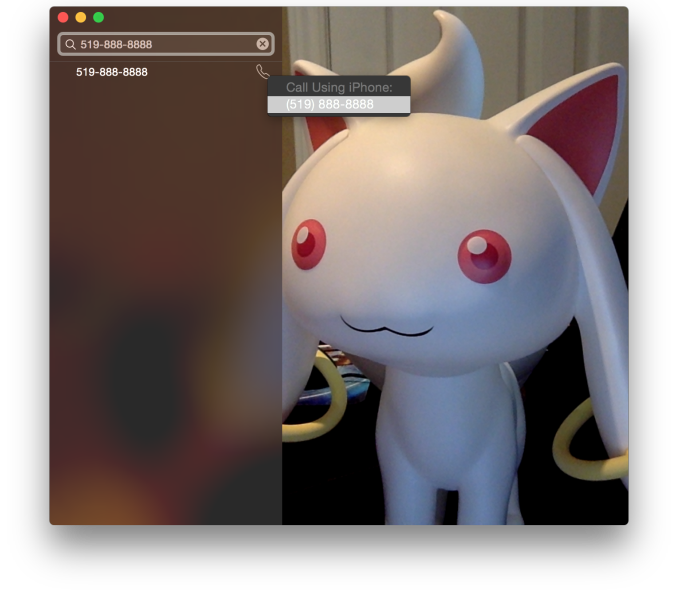 Using a Mac or an iPad for phone calls has a few more requirements than SMS, due to the greater speed required to audio compared to text. Both devices must be connected to the same WiFi network, and signed into the same Apple ID. To enable the feature the user must enable the iPhone Cellular Calls toggle in the FaceTime section of the iPhone settings application. It may seem odd that this setting is stored in the FaceTime menu rather than the Phone menu, but this is because of how Apple has integrated the feature into the FaceTime applications on the iPad and on OS X rather than building a separate Phone application. This works well and on the iPad there are no glaring issues. On OS X there is one oversight, which is that there is no dialer available to the user once a call has been made which prevents the use of extensions, or navigating menus without picking up your iPhone to do so.
Using a Mac or an iPad for phone calls has a few more requirements than SMS, due to the greater speed required to audio compared to text. Both devices must be connected to the same WiFi network, and signed into the same Apple ID. To enable the feature the user must enable the iPhone Cellular Calls toggle in the FaceTime section of the iPhone settings application. It may seem odd that this setting is stored in the FaceTime menu rather than the Phone menu, but this is because of how Apple has integrated the feature into the FaceTime applications on the iPad and on OS X rather than building a separate Phone application. This works well and on the iPad there are no glaring issues. On OS X there is one oversight, which is that there is no dialer available to the user once a call has been made which prevents the use of extensions, or navigating menus without picking up your iPhone to do so.
There are lots of reasons why a user would want to disable the cellular call support on their devices. For example, having your computer or iPad ring isn't really necessary if you have an iPhone dock on your desk. Disabling the feature on an iPad is as simple as disabling the switch in the FaceTime section of the Settings application. It's a bit more hidden on OS X. Users will have to open FaceTime, and then disable it from the Preferences menu for FaceTime that is accessible from the menu bar.
For those who do want it enabled, I've found that in practice the feature works, and it works well. I haven't encountered any issues with audio quality or delays. I don't receive many phone calls, but when I do I find myself answering them from my computer rather than my phone. However, I still make outgoing calls from my iPhone. Making phone calls from the computer will likely require more behaviour adaptation than receiving them because of the notification you receive with incoming calls. Having an actual dialer would help too.
SMS Forwarding
SMS Forwarding was a long desired feature. Having iMessages sync between devices has always been a great feature, but SMS was left out which meant that conversations with non-Apple users were confined to the iPhone. With OS X Yosemite and iOS 8.1, Apple has enabled the ability to send and receive SMS messages across all of your Apple devices. Enabling it is fairly simple. The Messages section of the Settings application has a new subsection called Text Message Forwarding. Inside is a list of all devices associated with your Apple ID, and flipping the slider on one brings up a keyboard and an input field with instructions to enter the code that will be displayed on that respective device. Once this is complete, SMS message support will be enabled on that device. Below is an image of the security code displayed in the Messages app on OS X when enabling SMS Forwarding.
Contrary to what you may read from other sources, SMS Forwarding does not require devices to be on the same WiFi network or to have Bluetooth enabled. To test this, I disabled Bluetooth on a computer running OS X Yosemite, and connected it to a WiFi network. I also took an iPhone 6 and disabled both Bluetooth and WiFi. I then went very far out of both WiFi and Bluetooth range. I sent a text message and then promptly switched off the iPhone. When I had returned to my room, the SMS message was displayed in the OS X messages app, which means it had to have been transferred by another method.
So what is the method of transfer? Well, there is one requirement to use SMS Forwarding. A device must have iMessage enabled. This confirms my suspicions from the original iOS 8 review that the feature works by sending iMessages silently to and from the iPhone, and SMS messages are then sent to the proper phone number.
This is honestly the most sensible way to go about implementing this sort of feature. Leveraging iMessage means that Apple can avoid having synchronization issues with the SMS messages. A system where messages were transmitted over a Bluetooth LE or WiFi direct connection would mean that any SMS messages sent or received when not in proximity to the iPad or Mac would not show up on those devices. It would be a poor user experience.
Once your setup is complete, you're ready to go. SMS messages can be sent and receives in the Messages app. All phone numbers not associated with iMessage will now default to an SMS message thread, and threads that contain both SMS messages and iMessages will now display both in the same style as the iPhone. This is definitely my favorite feature in iOS 8.1 and Yosemite, because it lets me respond to SMS messages without interrupting my workflow.



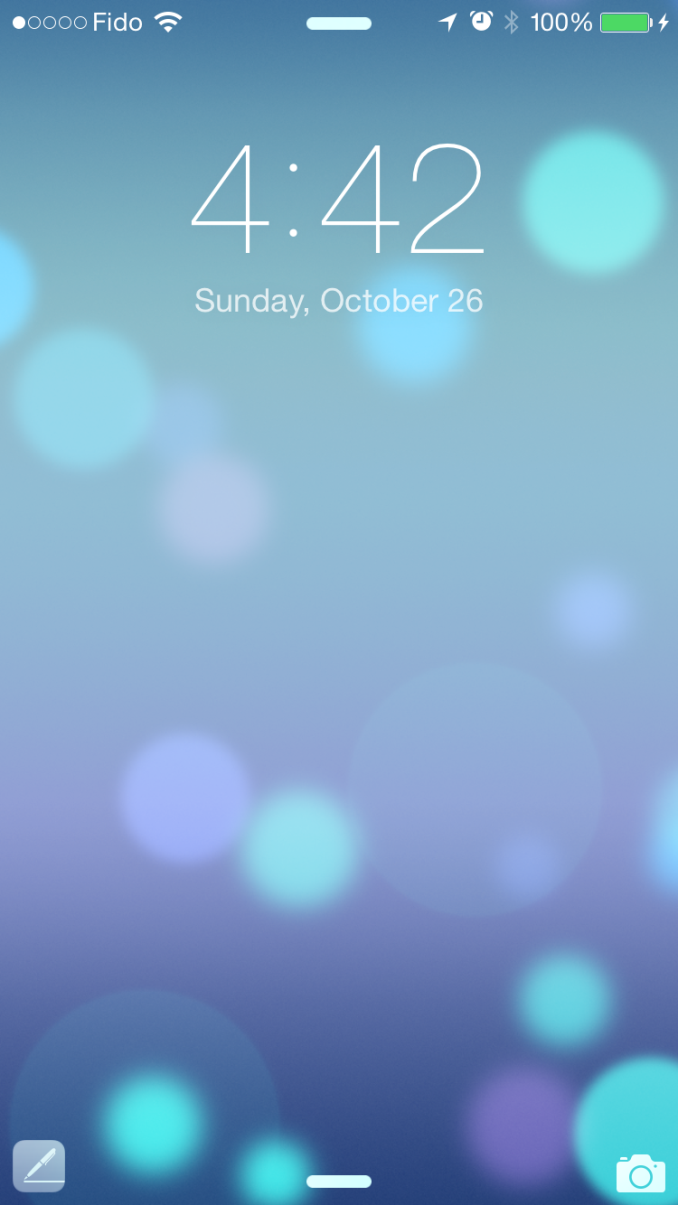
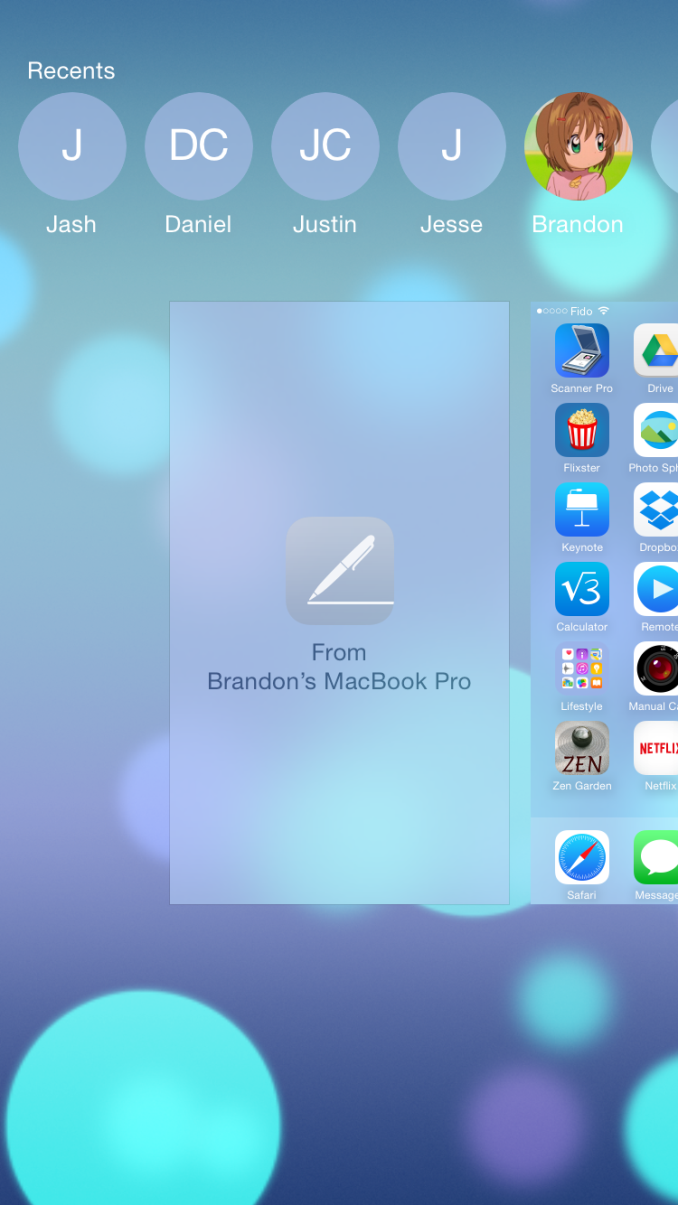

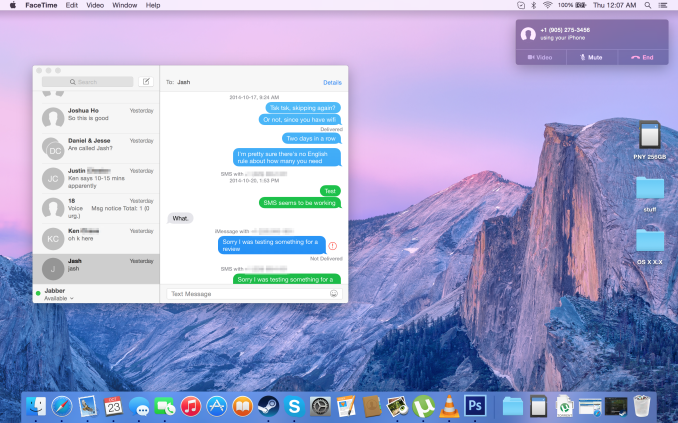
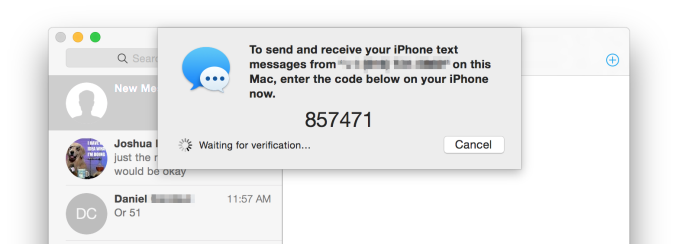








173 Comments
View All Comments
sunnohh - Friday, October 31, 2014 - link
Why on earth do you expect a pc to work after warranty? Actually it sounds like it was engineered perfectly.name99 - Monday, October 27, 2014 - link
God this is ignorant.What components do you expect to fail which require a "completely new purchase"?
Let's go through my various macs:
I have an HTPC mac mini. Internal HD has failed, so I boot it off an SSD I stuck in a firewire enclosure.
I have an old 17" PPC-based Macbook Pro with a sticky keyboard and more or less dead trackpad (belonged to a friend who spilled coffee on it). I use it as a digital clock.
I have a friend's old macbook air. He (different friend) spilled diet soda on it. The screen doesn't work, neither does the keyboard. So I plugged it into a (VGA-based) LCD screen that's 10+ years old, connected a USB keyboard, and it works fine for my needs.
I had an old Macbook whose fan died. Not ideal, but I directed an external fan at it, and kept it running for about three more years.
etc etc. In my experience Macs last longer than PCs, and they're only getting more reliable. The part that was most likely to fail was the HD, which is gone from portables and on its way out on desktops. The GPU tended to run too hot in desktop machines from around 2006/2007 and so provided a point of failure, but nothing tends to run too hot in a modern mac. etc etc
And when things DO fail, you can generally work around the problem pretty easily to maintain the machine as useful IF YOU WANT TO. If you are such a princess that you refuse to engage in such workarounds, that's your decision, not Apple's.
Sleepingforest - Thursday, October 30, 2014 - link
You spent extra money on an external enclosure, one of your laptops is a clock, another one is anchored in place with a keyboard and display, and the third needs a fan to be function. NONE of the latter are working laptops, in the sense of a portable computing device. And the HTPC required you to spend a non-trivial amount to keep it working.Significantly reduced functionality is not the same as "working," and expecting an expensive product to last in full working condition without cumbersome hacks is not the same as being a princess. If I have shoes with huge holes in the bottom I don't think "well at least it still covers the top of my foot." I replace it because it no longer fulfills it's primary role of protecting the bottom of my food, regardless of any auxiliary tasks it may still perform (and poorly at that).
FATCamaro - Monday, October 27, 2014 - link
Trolling. Not an MBPro owner or a 13 year OSX user. Check this users posts later in the thread. They are nonsensical coming from someone who is a 13 year OS user.ViewRoyal - Monday, October 27, 2014 - link
Good one! (͡° ͜ʖ°)You are right. We come across too many of these dishonest trolls, who are just out to be a nuisance to REAL users in the comments section..
KPOM - Monday, October 27, 2014 - link
What's wrong with the new iMac? I was impressed that they pulled off a 5K display on a $2499 computer.LostAlone - Tuesday, October 28, 2014 - link
The display is great. Pity that it can only run at 30fps at 5k though. And pity it doesn't have anything like the graphics muscle to actually display anything other than pictures at 5k too. And unlike proper computers, you can't upgrade, so you'll be making a MASSIVE sacrifice to get all those pixels. If you ever want to do anything other than look at digital photos at 5k, then you need to look elsewhere. Congrats to Apple for selling a system around a 5k display that is utterly unsuited to doing anything that requires a 5k display.ex2bot - Tuesday, October 28, 2014 - link
Wrong! You are wrong, sir! I cannot list how many ways.:) Seriously, I'm not a huge fan of iMacs, though I am a huge fan of Apple laptops. Your statement that the only thing the iMacs are good for is viewing pictures is ridiculously wrong. Almost as if it's a sport to you or something. The iMacs have fast processors and decent GPUs. They'd be great for photographers and general computing tasks. How about editing 4k video? They can handle that just fine.
To recap: WRONG!
Sleepingforest - Thursday, October 30, 2014 - link
You really think a quad core mobile processor is enough (and that's exactly what it is, a mobile processor thanks to Apple's focus on the thickness of a *desktop*) to drive 4K video editing? 4K video editing is a slow crawl on my 8 thread overclocked desktop.x3n0n1c - Friday, October 31, 2014 - link
The iMacs use Desktop class CPUs, always have. The only exception to that is the very lowest model which uses the internals of a macbook air to cut cost.The GPUs are mobile class.